MENU
The Electronic Scholarly Publishing Project: Providing access to classic scientific papers and other scholarly materials, since 1993. More About: ESP | OUR CONTENT | THIS WEBSITE | WHAT'S NEW | WHAT'S HOT
Comparative Timelines
The ESP Timeline (one of the site's most popular features) has been completely updated to allow the user to select (using the timeline controls above each column) different topics for the left and right sides of the display.
Select:
New Left Column
New Left Column
Dates
Decade
New Right Column
New Right Column
German poet Johann Wolfgang von Goethe writes The Morphology of Plants stating that all plant organs, flowers included, began as leaves — an assertion that will enjoy some support from 21st-century genetic research.
1790
(no entry for this year)
British doctors find that snuff leads to increased risk of nose cancer.
 Luigi Galvani announces that electricity applied to severed frog's legs causes them to twitch and that frogs legs twitch in the presence of two different metals with no electric current present. The latter discovery eventually leads to Alessandro Volta's developing the electric battery.
Luigi Galvani announces that electricity applied to severed frog's legs causes them to twitch and that frogs legs twitch in the presence of two different metals with no electric current present. The latter discovery eventually leads to Alessandro Volta's developing the electric battery.
 Pierre Prévost develops his theory of exchanges of radiation of heat. He correctly shows that cold is merely the absence of heat and that all bodies continually radiate heat. If they seem not to radiate heat, it means that they are in heat equilibrium with their environment.
Pierre Prévost develops his theory of exchanges of radiation of heat. He correctly shows that cold is merely the absence of heat and that all bodies continually radiate heat. If they seem not to radiate heat, it means that they are in heat equilibrium with their environment.
1791
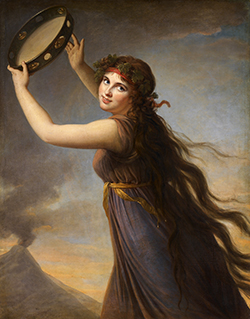 Painting by Élisabeth Vigée Le Brun: Lady Hamilton as a Bacchante Emma, Lady Hamilton, model and actress, is best remembered as the mistress of Lord Nelson and as the muse of George Romney. She was born Amy Lyon in Ness near Neston, Cheshire, England, the daughter of Henry Lyon, a blacksmith who died when she was two months old. She was raised by her mother, the former Mary Kidd, at Hawarden, and received no formal education. She later changed her name to Emma Hart.
Painting by Élisabeth Vigée Le Brun: Lady Hamilton as a Bacchante Emma, Lady Hamilton, model and actress, is best remembered as the mistress of Lord Nelson and as the muse of George Romney. She was born Amy Lyon in Ness near Neston, Cheshire, England, the daughter of Henry Lyon, a blacksmith who died when she was two months old. She was raised by her mother, the former Mary Kidd, at Hawarden, and received no formal education. She later changed her name to Emma Hart.
(no entry for this year)
1792
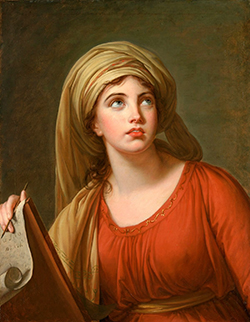 Painting by Élisabeth Vigée Le Brun: Lady Hamilton as the Persian Sibyl, commissioned by the Duc de Brissac and painted in Naples, a copy of which was sent to Sir William. This portrait gained great fame wherever it was displayed, and was instrumental in the rise of Le Brun's career as a portrait artist.[ Emma, Lady Hamilton, model and actress, is best remembered as the mistress of Lord Nelson and as the muse of George Romney. She was born Amy Lyon in Ness near Neston, Cheshire, England, the daughter of Henry Lyon, a blacksmith who died when she was two months old. She was raised by her mother, the former Mary Kidd, at Hawarden, and received no formal education. She later changed her name to Emma Hart.
Painting by Élisabeth Vigée Le Brun: Lady Hamilton as the Persian Sibyl, commissioned by the Duc de Brissac and painted in Naples, a copy of which was sent to Sir William. This portrait gained great fame wherever it was displayed, and was instrumental in the rise of Le Brun's career as a portrait artist.[ Emma, Lady Hamilton, model and actress, is best remembered as the mistress of Lord Nelson and as the muse of George Romney. She was born Amy Lyon in Ness near Neston, Cheshire, England, the daughter of Henry Lyon, a blacksmith who died when she was two months old. She was raised by her mother, the former Mary Kidd, at Hawarden, and received no formal education. She later changed her name to Emma Hart.
Reverend James Douglas publishes Nenia Britannica; or, A Sepulchral History of Great Britain providing perhaps the first record of a fossil (sea urchin) at an archaeological site.
1793
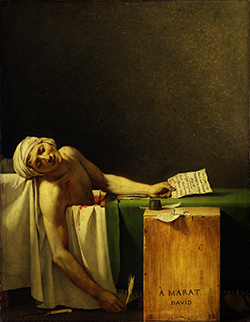 Painting by Jacques-Louis David: The Death of Marat (French: La Mort de Marat or Marat Assassiné) is one of the most famous images of the French Revolution. David was the leading French painter, as well as a Montagnard and a member of the revolutionary Committee of General Security. The painting shows the radical journalist lying dead in his bath on 13 July 1793 after his murder by Charlotte Corday. Painted in the months after Marat's murder, it has been described by T. J. Clark as the first modernist painting, for "the way it took the stuff of politics as its material, and did not transmute it".
Painting by Jacques-Louis David: The Death of Marat (French: La Mort de Marat or Marat Assassiné) is one of the most famous images of the French Revolution. David was the leading French painter, as well as a Montagnard and a member of the revolutionary Committee of General Security. The painting shows the radical journalist lying dead in his bath on 13 July 1793 after his murder by Charlotte Corday. Painted in the months after Marat's murder, it has been described by T. J. Clark as the first modernist painting, for "the way it took the stuff of politics as its material, and did not transmute it".
John Frere describes and illustrates handaxes from Hoxne that will turn out to be some 400,000 years old.
 Erasmus Darwin (Charles' grandfather) publishes Zoonomia, or the Laws of Organic Life.
Erasmus Darwin (Charles' grandfather) publishes Zoonomia, or the Laws of Organic Life.
James Hutton publishes An Investigation of the Principles of Knowledge. Buried in the 2,138-page philosophical tome is a chapter about variety in nature in which Hutton anticipates Charles Darwin's theory of natural selection.
 John Dalton's Extraordinary facts relating to the vision of colors gives an early account of red-green color blindness, which he refers to as Daltonism, since he is afflicted with the condition.
John Dalton's Extraordinary facts relating to the vision of colors gives an early account of red-green color blindness, which he refers to as Daltonism, since he is afflicted with the condition.
 Zoonomia, or the Laws of Organic Life by Erasmus Darwin (grandfather of Charles Darwin) contains his ideas about evolution, which are Lamarckian in that they assume the environment has a direct influence on organisms, causing permanent changes in the germ line.
Zoonomia, or the Laws of Organic Life by Erasmus Darwin (grandfather of Charles Darwin) contains his ideas about evolution, which are Lamarckian in that they assume the environment has a direct influence on organisms, causing permanent changes in the germ line.
 Alessandro Volta demonstrates that the electric force observed by Galvani is not connected with living creatures, but can be obtained whenever two different metals are placed in a conducting fluid.
Alessandro Volta demonstrates that the electric force observed by Galvani is not connected with living creatures, but can be obtained whenever two different metals are placed in a conducting fluid.
1794
(no entry for this year)
 James Hutton's Theory of the Earth published, interpreting certain geological strata as former sea beds. Hutton proposes geological theory of gradualism.
James Hutton's Theory of the Earth published, interpreting certain geological strata as former sea beds. Hutton proposes geological theory of gradualism.
Johann Friedrich Blumenbach publishes De generis humani varietate nativa liber arguing that humans comprise a single species with five varieties: Caucasian, Mongolian, Ethiopian, (American) Indian and Malayan.
James Hutton overturns the "Neptunian" view of rock formation in his Theory of the Earth, suggesting instead that forces of rock creation are balanced by forces of rock destruction.
1795
(no entry for this year)
(no entry for this year)
1796
(no entry for this year)
(no entry for this year)
1797
(no entry for this year)
 Publication of Thomas Malthus' Essay on the Principle of Population, a work that Darwin asserted helped him frame the principle of evolution by natural selection.
Publication of Thomas Malthus' Essay on the Principle of Population, a work that Darwin asserted helped him frame the principle of evolution by natural selection.
Henry Cavendish determines the mass of Earth by measuring the gravity between two small masses and two large masses. This gives the gravitational constant G, which was the only unknown in Newton's equations. Solving for G enables Cavendish to establish that Earth is about 5.5 times as dense as water.
 Enquiry concerning the source of heat which is excited by friction by Count Rumford (Benjamin Thompson) describes his experiments with boring cannons that show that the caloric theory of heat cannot be true, and that heat should be considered a kind of motion.
Enquiry concerning the source of heat which is excited by friction by Count Rumford (Benjamin Thompson) describes his experiments with boring cannons that show that the caloric theory of heat cannot be true, and that heat should be considered a kind of motion.
1798
(no entry for this year)
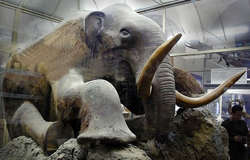 The first mammoth fossil fully documented by modern science is discovered near the delta of the Lena River in 1799 by Ossip Schumachov, a Siberian hunter. Schumachov allows it to thaw (a process taking several years) until he can retrieve the tusks for sale to the ivory trade in Yakutsk. He then abandons the specimen, allowing it to decay before its recovery. In 1806, Russian botanist Mikhail Adams rescues what remained of the specimen and brought it to the Zoological Museum of the Zoological Institute of the Russian Academy of Sciences in St. Petersburg. The specimen, which became known as the Adams Mammoth, is stuffed and mounted, and continues to be on display at the Zoological Institute.
The first mammoth fossil fully documented by modern science is discovered near the delta of the Lena River in 1799 by Ossip Schumachov, a Siberian hunter. Schumachov allows it to thaw (a process taking several years) until he can retrieve the tusks for sale to the ivory trade in Yakutsk. He then abandons the specimen, allowing it to decay before its recovery. In 1806, Russian botanist Mikhail Adams rescues what remained of the specimen and brought it to the Zoological Museum of the Zoological Institute of the Russian Academy of Sciences in St. Petersburg. The specimen, which became known as the Adams Mammoth, is stuffed and mounted, and continues to be on display at the Zoological Institute.
Charles White publishes An Account of the Regular Gradation in Man, and in Different Animals and Vegetables, a treatise on the great chain of being, showing people of color at the bottom of the human chain.
Faujas publishes a description of the Maastricht animal, a spectacular mosasaur found in chalk quarries in the Netherlands, describing it as a crocodile.
Thomas Jefferson publishes a paper describing Megalonyx, a North American fossil ground sloth similar to the one found in South America.
George Shaw publishes a description of a platypus even though he suspects the odd animal might be a hoax.
Alexander von Humboldt names the Jurassic System, after the Jura Mountains. This time period will later be identified as the "middle period" for the dinosaurs.
William Smith maps rock formations in the vicinity of Bath, England, making perhaps the world's first geologic map. The same year, Smith, Joseph Townsend and Benjamin Richardson recognize rocks containing the Permian and Triassic, though not necessarily by those names. (These periods will later be identified as spanning the Earth's most catastrophic mass extinction.)
The British government purchases the collection of Scottish anatomist John Hunter, forming the Hunterian Museum.
1799
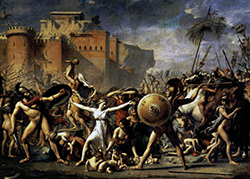 Painting by Jacques-Louis David: The Intervention of the Sabine Women shows a legendary episode following the abduction of the Sabine women by the founding generation of Rome. The genesis of Les Sabines and the work itself represented a significant departure for the day. Historical depictions had been typically commissioned. David however, conceived, produced and promoted his work for profit. He produced marketing material to accompany the first exhibition. Le Tableau des Sabines, Exposé Publiquement au Palais National des Sciences et des Arts "the Tableau of the Sabines, Public Exhibition at the National Palace of Arts and Science" contained his own account of the episode and anticipated the controversy over his use of nudity with an end-note explaining his rationale. Its 1799 exhibition attracted a large number of paying visitors for several years and in 1819 he sold Les Sabines and his L onidas at Thermopylae to the Royal Museums for 10,000 francs.
Painting by Jacques-Louis David: The Intervention of the Sabine Women shows a legendary episode following the abduction of the Sabine women by the founding generation of Rome. The genesis of Les Sabines and the work itself represented a significant departure for the day. Historical depictions had been typically commissioned. David however, conceived, produced and promoted his work for profit. He produced marketing material to accompany the first exhibition. Le Tableau des Sabines, Exposé Publiquement au Palais National des Sciences et des Arts "the Tableau of the Sabines, Public Exhibition at the National Palace of Arts and Science" contained his own account of the episode and anticipated the controversy over his use of nudity with an end-note explaining his rationale. Its 1799 exhibition attracted a large number of paying visitors for several years and in 1819 he sold Les Sabines and his L onidas at Thermopylae to the Royal Museums for 10,000 francs.
ESP Quick Facts
ESP Origins
In the early 1990's, Robert Robbins was a faculty member at Johns Hopkins, where he directed the informatics core of GDB — the human gene-mapping database of the international human genome project. To share papers with colleagues around the world, he set up a small paper-sharing section on his personal web page. This small project evolved into The Electronic Scholarly Publishing Project.
ESP Support
In 1995, Robbins became the VP/IT of the Fred Hutchinson Cancer Research Center in Seattle, WA. Soon after arriving in Seattle, Robbins secured funding, through the ELSI component of the US Human Genome Project, to create the original ESP.ORG web site, with the formal goal of providing free, world-wide access to the literature of classical genetics.
ESP Rationale
Although the methods of molecular biology can seem almost magical to the uninitiated, the original techniques of classical genetics are readily appreciated by one and all: cross individuals that differ in some inherited trait, collect all of the progeny, score their attributes, and propose mechanisms to explain the patterns of inheritance observed.
ESP Goal
In reading the early works of classical genetics, one is drawn, almost inexorably, into ever more complex models, until molecular explanations begin to seem both necessary and natural. At that point, the tools for understanding genome research are at hand. Assisting readers reach this point was the original goal of The Electronic Scholarly Publishing Project.
ESP Usage
Usage of the site grew rapidly and has remained high. Faculty began to use the site for their assigned readings. Other on-line publishers, ranging from The New York Times to Nature referenced ESP materials in their own publications. Nobel laureates (e.g., Joshua Lederberg) regularly used the site and even wrote to suggest changes and improvements.
ESP Content
When the site began, no journals were making their early content available in digital format. As a result, ESP was obliged to digitize classic literature before it could be made available. For many important papers — such as Mendel's original paper or the first genetic map — ESP had to produce entirely new typeset versions of the works, if they were to be available in a high-quality format.
ESP Help
Early support from the DOE component of the Human Genome Project was critically important for getting the ESP project on a firm foundation. Since that funding ended (nearly 20 years ago), the project has been operated as a purely volunteer effort. Anyone wishing to assist in these efforts should send an email to Robbins.
ESP Plans
With the development of methods for adding typeset side notes to PDF files, the ESP project now plans to add annotated versions of some classical papers to its holdings. We also plan to add new reference and pedagogical material. We have already started providing regularly updated, comprehensive bibliographies to the ESP.ORG site.
ESP Picks from Around the Web (updated 06 MAR 2017 )
Old Science

Weird Science

Treating Disease with Fecal Transplantation
Fossils of miniature humans (hobbits) discovered in Indonesia

Dinosaur tail, complete with feathers, found preserved in amber.
Astronomy

Mysterious fast radio burst (FRB) detected in the distant universe.